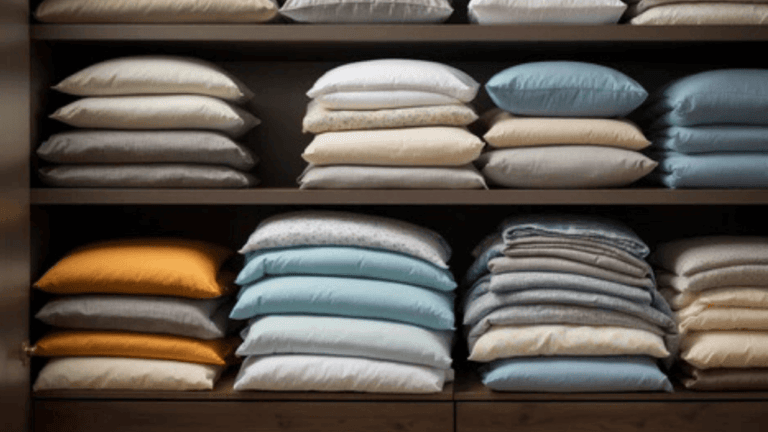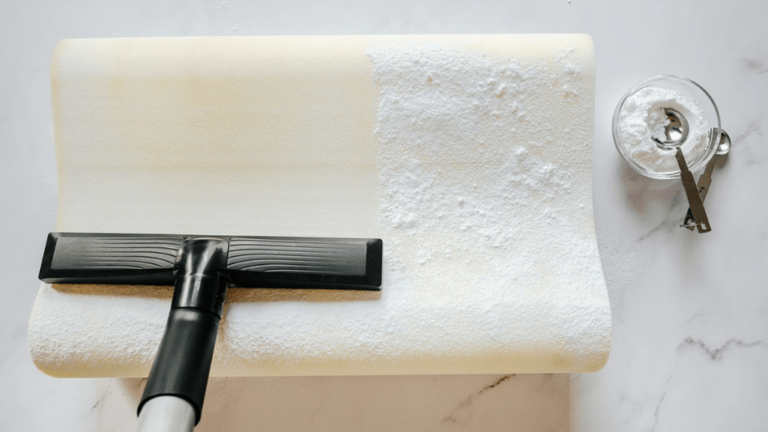Getting a good night’s sleep is super important. It affects both our mental and physical health. The condition of our pillows plays a huge part in this. It’s critical to keep our pillows clean and supportive for the best sleep environment.
If we don’t take care of our pillows, we can face problems. These include allergic reactions, skin issues, and neck pain. The experts say we should change our pillows every one to two years. This keeps them fresh and supportive. Following this advice can lead to better sleep and lower health risks.
Key Takeaways
- Most pillows should be replaced every one to two years for optimal support and hygiene.
- Polyester pillows may last just one year, while latex pillows can last up to four years.
- Down alternative pillows have a lifespan of approximately one to two years.
- Maintaining pillow cleanliness by washing every three to six months can extend their lifespan.
- Using pillow protectors can help reduce wear and allergens, enhancing pillow longevity.
Why It’s Important to Replace Pillows Regularly
It’s vital to keep your pillows fresh for good health and sleep. Learning when to get new pillows and how to care for them well is crucial. It helps boost your well-being.
Health Risks of Using Old Pillows
Old pillows collect dust mites, pet dander, fungus, and mold. These things can cause a lot of problems like a runny nose or itchy eyes. Changing pillows every 1 to 2 years keeps them clean and reduces these health threats.
Impact on Sleep Quality
Having old pillows can mess with how well you sleep. Dirty pillows can make your skin break out or feel itchy. They may also not support your neck well, leading to aches and bad sleep posture.
Possible Allergic Reactions
Not swapping old pillows can cause allergies. You might start sneezing more, or your eyes could get red and itchy. Following pillow care advice and changing pillows as needed fights these issues and helps you sleep better.
In short, watching out for when to replace pillows and taking care of them means a cleaner and more supportive sleep space. This makes you feel better and sleep more soundly.
How Often Should You Get New Pillows
It’s key to know when to switch out your pillows. This helps keep your sleep quality high and your bed clean. Pillows last differently based on their material.
For best results, follow what the maker says. Also, remember some key tips about each pillow type’s lifespan. This way, you’ll sleep better and more healthily.
Manufacturer Recommendations
Pillow makers give advice on when to get a new one. Top memory foam and latex pillows can last many years. But, polyester ones need replacing more often. Here’s a general guide:
- Memory foam pillows: every 2 to 3 years
- Latex pillows: every 2 to 4 years
- Polyfoam pillows: every 2 to 3 years
- Polyester pillows: every 6 months to 2 years
- Down/feather pillows: every 1 to 3 years
- Buckwheat pillows: rejuvenate by replacing the buckwheat hulls approximately once every 3 years
General Guidelines by Material
Knowing your pillow’s material helps too. Follow these guidelines to know when it’s time for a change. This keeps your pillows fresh and your sleep better:
| Pillow Material | Recommended Replacement Time |
|---|---|
| Polyester | 1 year |
| Down alternative | 1 to 2 years |
| Memory foam | 2 to 3 years |
| Polyfoam | 2 to 3 years |
| Down/Feather | 1 to 3 years |
| Latex | 2 to 4 years |
| Buckwheat | Every 3 years (replace hulls) |
Keeping up with when to change pillows is a game-changer for your bedding. So, stick to these tips for swapping out pillows. It’ll make your sleep and health better.
Signs It’s Time to Replace Your Pillow
A regular pillow care routine can make your pillow last longer. But, if it shows some signs, like being flat or lumpy, it might be hopeless. These issues can hurt both your sleep and health.
Sagginess and Lumps
Sometimes, a pillow just gets old. It starts to sag or get lumpy. This loss of shape means it’s not supporting your head and neck well. You can do the bend test. If the pillow doesn’t go back to its original shape, it’s time to replace it.
Discoloration and Odors
Over time, pillows collect sweat, oils, and germs. They get stains and start to stink. These signs could point to mold or bacteria. If you’ve cleaned your pillow and it’s still smelly, it’s best to just get a new one.
Increased Allergy Symptoms
Has your pillow been making you sneeze or feel itchy? It might have dust mites. These little bugs and their droppings love to hide in old pillows. If you’re allergic, consider changing your pillow more often. Cleaning your pillow regularly is good. But, sometimes you just need a fresh one for a clean sleep.
Factors Affecting Pillow Lifespan
A pillow’s life can vary based on materials, how often it’s washed, and how it’s maintained. Pillows made of latex or memory foam last longer than feather ones, lasting up to two years.
Shopping for quality is smart. Better pillows offer great support and stay cool. Remember, price isn’t everything. Think about what you need your pillow to do.
| Material Type | Lifespan | Care Recommendations |
|---|---|---|
| Memory Foam | 2-3 years | Spot clean regularly, avoid excessive water. |
| Latex | 3-4 years | Spot clean, use pillow covers. |
| Down/Feather | 5-10 years | Regular washing every six months, use protective covers. |
| Synthetic | 1-2 years | Wash twice a year or quarterly. |
Take care of your pillows for them to last longer. Pillow care includes regular washes and using protectors. This is especially crucial in hot places.
By understanding and following these tips, pillows can last longer. This means more support and comfort for you.
Pillow Material and Durability
A pillow’s lifespan is mainly tied to what it’s made of. To keep your pillow comfy for longer, know how to care for it. Let’s look at common pillow types, their durability, and how to take care of them:
Memory Foam
Memory foam pillows last a long time, about 2 to 3 years. They give great support and shape to your head and neck. Remember, don’t machine wash them. Instead, spot clean them. Also, using a protective cover keeps them clean.
Polyfoam
Polyfoam pillows are soft but don’t last as long, around 1 to 2 years. Follow the care label when cleaning them. Often, it’s spot cleaning or gentle machine wash. Despite not lasting as long, they’re budget-friendly.
Watch out for sagginess and lumps to know when to replace them.
Feather/Down
Down and feather pillows are soft and can stay comfy for 1 to 3 years. Clean them every 3 to 6 months if they’re machine washable. Fluff them up regularly. The best quality ones keep their shape for 10 to 15 years.
Latex
Latex pillows are very durable, lasting 2 to 4 years. They fight off dust mites and mold, so they’re good for you and last longer. Remember not to wash them in a machine. Clean them gently. Plus, they’re an eco-friendly choice.
Polyester and Down Alternatives
These pillows don’t last as long, usually 6 months to 2 years. They’re great for your wallet though. To make them last a bit longer, use pillow protectors. Always check the care label before washing them.
Buckwheat
Buckwheat pillows can last up to 20 years if you care for them well. Replace the hulls every 3 years for the best support. They’re free of harmful chemicals. Keep them dry to avoid mold and bacteria. And, airing them out in the sun is good for them.
By following these suggestions, you can make your pillow last longer. Choosing the right material and caring for it properly ensures a good night’s sleep for years.
Pillow Care Tips to Prolong Lifespan
Taking a proactive approach to pillow care helps them last longer. It also keeps your sleep clean and supportive. Follow our advice and tips to make your pillows last as long as possible.
Regular Washing and Cleaning
Pillow care advice stresses the importance of regular washing and cleaning. How you clean your pillow depends on its material:
- Down/feather pillows can go in the machine. Down alternative pillows should be washed every 3 to 6 months.
- Memory foam and latex pillows should only be cleaned with warm water and mild detergent, and not machine washed.
- Polyfoam pillows require hand washing every 2 to 3 months. This prevents damage to the material.
Don’t forget to wash your pillowcases too. Washing them once a week helps prevent allergens from building up.
Using Protective Covers
Protective covers play a vital role in keeping your pillows fresh. They protect from allergens, fluids, and wear, which makes your pillows last longer. You can wash these covers often, keeping your sleep area cleaner and your pillows in better shape. This also cuts down on how often you have to buy new pillows.
By following these simple steps, you’ll enjoy a supportive, clean sleep. These practices extend your pillows’ life. Always sticking to a regular pillow cleaning routine improves your sleep and is a smart way to care for your pillows.
Pillow Maintenance Schedule
Keeping your pillow clean is key to making it last longer and ensuring you sleep well. It’s important to wash the pillowcases often and clean the pillows themselves from time to time. This routine should fit the kind of pillow you have. Following these steps can make your pillows last longer.
| Pillow Type | Cleaning Method | Washing Frequency | Replacement Timeline |
|---|---|---|---|
| Down/Feather | Machine wash or dry clean | Every 6 months | 1-2 years |
| Memory Foam | Spot clean or hand wash | Every 2 months | 2.8 years |
| Polyester/Down Alternative | Machine wash | Every 3-6 months | 6 months to 2 years |
| Latex | Spot clean or hand wash | Every 2-3 months | 2-4 years |
Sticking to a regular maintenance plan is great for keeping your pillows in shape and free from allergens. For example, you should wash down and feather pillows every six months. Memory foam pillows need a different care; you should spot clean them or hand wash every two months. Doing this will help your pillow last longer.
It’s also crucial to know when to change your pillows, as different materials mean different replacement times. This keeps your sleep quality high and reduces your risk of health problems. Keeping your pillowcases clean and doing a deep clean when needed helps your pillows stay in good shape and remain hygienic.
Expert Recommendations on Pillow Care
Caring for pillows is key to a healthy sleep spot. Experts offer tips to lengthen your pillows’ life and keep them effective. We share expert insights and top tips for pillow care.
Quotes from Sleep Experts
Dr. Michael Breus says, “Keep your pillow clean for the best sleep. Use a high-loft pillow if you sleep on your side for the right head and neck support.” This advice shows how important it is to pick the correct pillow for your sleep style.
Dr. Neil Stanley adds, “Pillows can’t be used forever. They stop supporting your head over time, making you uncomfortable.” It’s usually a good idea to get a new pillow every 1 to 2 years, he says.
Best Practices for Pillow Hygiene
Using the right methods can make your pillows last longer. An antimicrobial, breathing pillow cover can keep mold and dust mites away. This might well cut back on allergies too.
I’ve made a handy table with tips on when to replace your pillow and how to care for it, based on what it’s made of:
| Pillow Material | Recommended Lifespan | Care Instructions |
|---|---|---|
| Polyester | 1 year | Machine wash every 3 to 6 months |
| Memory Foam | 2-3 years | Hand wash every 2 months |
| Polyfoam | 2-3 years | Hand wash every 2 to 3 months |
| Down/Feather | 1-3 years | Machine wash or dry clean |
| Latex | 2-4 years | Spot clean every 2 to 3 months |
| Buckwheat | Replace hulls every 3 years | Spot clean |
Following these tips and replacing your pillow as recommended improves sleep. By keeping your pillows clean and well-supported, you create a better sleeping space. For more details on when to change your pillow, check out this guide.
Conclusion
Keeping up with your pillows is key to getting good sleep and staying healthy. Know that pillows need changing every 1-2 years to keep dust mites away and stay comfy. This info helps spot when it’s time for new ones, like if they’re flat or cause more allergies.
Taking care of your pillows can make them last longer. Wash them every six months or quarterly, and use protective covers. It depends on what the pillows are made of, like latex or memory foam, which affects how long they’ll last. It’s important to pick the right kind of pillow for you and then take good care of it.
Changing your pillows regularly and caring for them means you’ll sleep better. Follow advice on when to get new pillows and watch for signs they need changing. This is critical for good sleep and better health.














